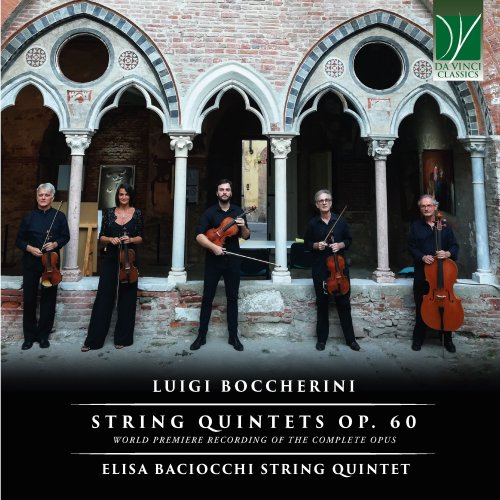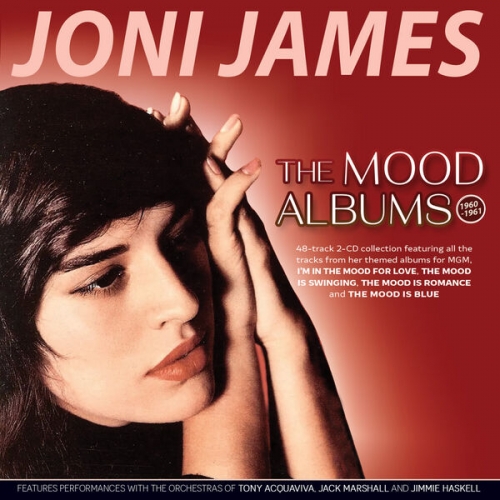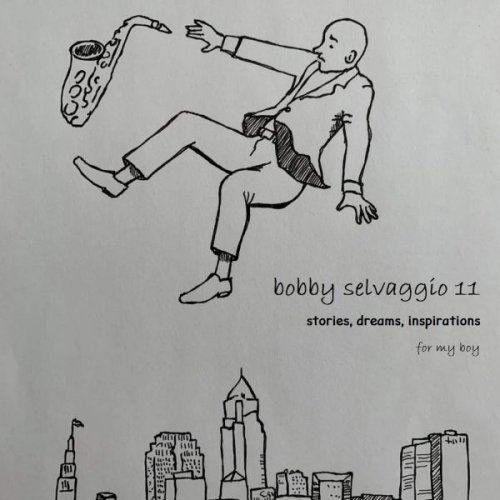Elisa Baciocchi String Quintet - Luigi Boccherini: String Quintets Op. 60 (2024)

Artist: Elisa Baciocchi String Quintet
Title: Luigi Boccherini: String Quintets Op. 60
Year Of Release: 2024
Label: Da Vinci Classics
Genre: Classical
Quality: flac lossless (tracks)
Total Time: 02:04:02
Total Size: 596 mb
WebSite: Album Preview
TracklistTitle: Luigi Boccherini: String Quintets Op. 60
Year Of Release: 2024
Label: Da Vinci Classics
Genre: Classical
Quality: flac lossless (tracks)
Total Time: 02:04:02
Total Size: 596 mb
WebSite: Album Preview
CD1
01. String Quintet No. 2 in B-Flat Major, Op. 60: I. Larghetto con moto
02. String Quintet No. 2 in B-Flat Major, Op. 60: II. Minuetto
03. String Quintet No. 2 in B-Flat Major, Op. 60: III. Grave
04. String Quintet No. 2 in B-Flat Major, Op. 60: IV. (Finale) Allegro assai
05. String Quintet No. 3 in A Major, Op. 60: I. Larghetto
06. String Quintet No. 3 in A Major, Op. 60: II. Allegro gaio
07. String Quintet No. 3 in A Major, Op. 60: III. Tempo di Minuetto
08. String Quintet No. 3 in A Major, Op. 60: IV. Allegretto
09. String Quintet No. 6 in F Major, Op. 60: I. Allegro moderato
10. String Quintet No. 6 in F Major, Op. 60: II. Minuetto
11. String Quintet No. 6 in F Major, Op. 60: III. Grave
12. String Quintet No. 6 in F Major, Op. 60: IV. Allegro giusto
CD2
01. String Quintet No. 1 in C Major, Op. 60: I. Allegro vivace
02. String Quintet No. 1 in C Major, Op. 60: II. Largo cantabile – Allegro giusto – Largo come prima
03. String Quintet No. 1 in C Major, Op. 60: III. Allegro con moto
04. String Quintet "omaggio a Luigi Boccherini", Op. 60: I. Allegro moderato
05. String Quintet "omaggio a Luigi Boccherini", Op. 60: II. Adagio molto
06. String Quintet "omaggio a Luigi Boccherini", Op. 60: III. Tempo di Minuetto
07. String Quintet "omaggio a Luigi Boccherini", Op. 60: IV. Rondò (Allegretto)
08. String Quintet No. 5 in G Major, Op. 60: I. Allegro con moto
09. String Quintet No. 5 in G Major, Op. 60: II. Minuetto
10. String Quintet No. 5 in G Major, Op. 60: III. Andantino
11. String Quintet No. 5 in G Major, Op. 60: IV. Allegro giusto
Boccherini was born in the Tuscan city of Lucca in 1743. He was the third child of Maria Santa and of Leopoldo Boccherini. Having received his first musical instruction from Leopoldo, Luigi, became a student of music at the local seminary, where he met Abbot Vannucci, an appreciated professor of cello, of harmony, and of counterpoint. Luigi’s progress was steady and quick, and already at thirteen he was employed as a cellist at theatres and churches of his birth city.
He would leave it soon, however; in 1757, we find him in Rome, where he would finish his musical studies under the guidance of G. B. Costanzi, a renowned cellist and composer who was the Chapel Master of the Papal Chapel. It is more than likely that Boccherini also profited from the teachings of the Corelli school for string players.
Boccherini seems to have longed for Lucca, however, and he repeatedly pleaded to receive an appointment as a musician in the Chapel orchestra of the Lucca Republic. At first, his pleas were unanswered, and so both Luigi and his father Leopoldo moved to Vienna, soon to be followed by some of Luigi’s siblings, who would build their careers as musicians or dancers at the Imperial Theatre of the Austrian capital. Luigi and Leopoldo remained in Vienna for just some months; in 1759 their presence is documented once more in Lucca, whilst in 1760 they were back in Vienna.
It was on that occasion that the first fruits of Luigi’s activity as a composer would appear in print.
One further year later, Luigi’s longing for Lucca became once more intense, and he asked the city authorities to grant him a salary as a performing musician. In the meantime, he went on issuing his op. 2 and op. 3; their composition was probably encouraged by his performances as a member of the first-ever Tuscan string quartet (composed by violinists P. Nardini and F. Manfredi, by violist G. G. Cambini, and by Boccherini himself as the cellist).
In 1763, Luigi and Leopoldo were once more in Vienna, where Luigi took the city by storm with his performances. In spite of this international acclaim, when Lucca eventually decided to attribute him the post of first cellist in the local orchestra, Boccherini immediately left the Empire’s capital for his birth city. The long-awaited appointment, however, proved less rosy than he had expected; already in 1765, he took leave with the official purpose of pursuing further musical studies in Milan, under the guidance of Giovanni Battista Sammartini.
From then on, he was to be intermittently in Lucca.Several of his works for Lucca are in the field of sacred music (including acclaimed oratorios), revealing his deep melodic vein and valuable religious inspiration.
After his father’s death, in 1766, Boccherini found a loyal music partner and friend in the violinist Nardini with whom he played in Quartet. Together, the two musicians travelled throughout Europe. Their stay in Paris (from 1767) proved to be a particularly successful experience, crowned by their performances at the prestigious series of the Concerts Spirituels, and by the publication of numerous works by Boccherini by Parisian printers.
In 1768, both Boccherini and Nardini left the French for the Spanish capital. Nardini’s career in Spain was quicker than Boccherini’s, due to rivalries with other musicians who feared the presence of the Italian virtuoso in their midst. Only in 1770 was Boccherini officially employed by don Luís of Spain, the Infante, to whom the composer would dedicate almost exclusively his works for the following fifteen years.
It was during those years that Boccherini began composing string quintets (with two cellos), probably in order to find a place for his talent without competing with the cellist who was at the Spanish court before him. In 1776, Boccherini was left in Spain by his friend Nardini, who went back to their birth city of Lucca, and was compelled to follow his patron, don Luís, to a remote palace where his situation became strikingly similar to Haydn’s in Esterháza.
Different from Haydn, however, Boccherini got married, and had also the pleasure of enjoying the company of one of his brothers, Gian Gastone. His wife was soon to die, however; in that same year 1785, Luigi was bereft also of his employer, don Luís. Having struggled for some months in the effort to find a suitable post, in 1786 Boccherini became a court composer to the King of Prussia, Frederick William II, to whom he would regularly send his chamber music works. In Spain, he eventually became the director and conductor of another court orchestra, that of Duchess María Josefa Alonso Pimentel. In spite of these positive beginnings, however, Boccherini remained at her court only for one year, when he left that position and got married for the second time.
Information about the following ten years (!) of his life is scanty.
The death of his Prussian patron stroke Boccherini’s fortunes once more, and providentially he was helped by the Marquis of Benavente who commissioned him several works, including some important arrangements. Whilst in Spain his fame was not widespread, his compositions were circulating extensively in Europe, and, in particular, his name was commonly known in Paris. His connection with France was crucial for establishing an important relationship with Luciano Bonaparte, the French Ambassador to Madrid (1800). It is to him that Boccherini would dedicate his two sets of String Quintets with two violas, op. 60 (recorded here) and op. 62. In 1802, Boccherini would seek the protection of another ruler, Czar Alexander I; but, between 1803 and 1804, his personal life would be disrupted once more by the loss of three of his daughters and of his second wife. In spite of his having sought shelter and comfort at the place of two of his sons, Boccherini would not survive these tragedies, and he died at their place in 1805.
The Quintets of op. 60 have an unclear genesis, on which light has been shed in recent years by some scholars. We have already seen that Boccherini frequently practised the art of transcription and arrangement. From the inventory of his works, we are informed that he had written two sets of sextets, of which no other trace has survived, and that they had been transcribed as string quintets. It is highly unlikely that these arrangements constitute what is known as op. 23, op. 16, op. 17, and op. 19.
It is more than likely, instead, that these sextets currently survive as the String Quintets of op. 60, recorded here in their complete form for the first time. For one thing, it is interesting that they were not sold to any publisher by Boccherini. Secondly, the set of parts for op. 62 currently found at the French National Library has a seemingly contradictory title-page, which reads: “Opera 62. | 1802 | Sei Quintetti. | For two violins, two violas, and two celli”. Rather than supposing a faulty arithmetic (quintets for six players?), we may reasonably surmise that this contradiction mirrors the origins of the two sets of Bonaparte Quintets. Furthermore, in the viola part of Quintet no. 6, op. 60 (G 396), there is another seeming error, i.e. the indication of 1781 as the date of composition. This would all make sense if we surmise that both opuses were written in the 1780s as sextets, and possibly also existed as quintets with two violas.
This album is completed by another premiere, the Quintet written by Claudio Valenti. About it, the composer writes:
The quintet I composed, following in the footsteps of Luigi Boccherini’s quintets op. 60, ideally replaces the lost fourth quintet in E-flat major. In crafting this work, I considered Boccherini’s language in relation to his era, yet I did not underestimate the originality that distinguishes him and renders him unique. The quintet consists of four movements: Allegro moderato, Adagio molto, Tempo di minuetto, and Rondò allegretto, all in E-flat major. The first Allegro, as often seen in Boccherini, progresses with inventions that freely succeed one another, resembling more closely the rondo form rather than the Viennese sonata. The Adagio molto draws inspiration from sacred compositions such as the beautiful “Stabat” op. 61 of 1781 for string quintet and soprano. Boccherini’s style of sacred composition favors the expressive use of counterpoint and imitation, reminding us that his great mastery in this practice is deeply rooted in the works of Italian madrigalists of the 16th and 17th centuries.
The second thematic idea, beginning at bar 16 in E-flat major as a harmonic opening contrasting with the initial objectivity of C minor, aims to follow a particular attention paid in Boccherini’s music to modulation. This practice, obligatory for all composers, assumes, as later seen in Schubert, a particular poetic significance, an opening towards a new sound world which is found only in a few compositions of the period.
The minuet, in the minor mode, has a trio in major supported by a triplet motion in the cello. This keyboard-like procedure, entrusted to the bowed instrument, assumes an almost soloistic standing, paying homage to the virtuoso cellist Boccherini, whose importance was fundamental for the evolution of this instrument.
The Rondò allegretto concludes the quintet in 3/4 time. The initial motif in E-flat major is quite recognizable as related to the theme of the first allegro. This motif, interspersed with various episodes, flows amiably throughout the movement: the choral use of the parts, in unison and in octaves in the forte passages, aims to allude to another compositional technique that Boccherini employs, juxtaposing the dialoguing character of the instrumental lines with more typical moments of discontinuity, in my view more characteristic of musical theater than of the graceful rococo chamber production.
In the central section, the triplets in the first violin add a touch of instrumental freshness, hopefully quite Boccherinian. Finally, I would like to draw the reader’s attention to an observation regarding op. 60 that guided me in composing this work: the two violas essentially play two roles, one typical of harmonic support realized with syncopations and offbeats, whose unexpected originality is unique in its kind. But also, the less typical yet more characteristic role of shaping the quintet’s sound, producing homorhythmic melodic elements in thirds and sixths, thus creating a timbral opening in the central part of the harmonic texture. This device contributes to creating that particular ensemble sound so typical of the op. 60 quintets, which also acquire a sweet, almost candlelit sonic quality for this reason.
![Max Buettner - Reconnect (2025) [Hi-Res] Max Buettner - Reconnect (2025) [Hi-Res]](https://www.dibpic.com/uploads/posts/2025-12/1766910938_cover.jpg)
![King Owusu, Pachakuti, young.vishnu - Siamo (2025) [Hi-Res] King Owusu, Pachakuti, young.vishnu - Siamo (2025) [Hi-Res]](https://www.dibpic.com/uploads/posts/2025-12/1767014690_a0952440070_10.jpg)
![Johnny Janis - Playboy Presents... Once In a Blue Moon (2015) [Hi-Res] Johnny Janis - Playboy Presents... Once In a Blue Moon (2015) [Hi-Res]](https://img.israbox.com/img/2025-12/29/hpechfkz7kpvyn01p0qdae2u4.jpg)

![Nighthawks - Paris Dakar (2025) [Hi-Res] Nighthawks - Paris Dakar (2025) [Hi-Res]](https://www.dibpic.com/uploads/posts/2025-12/1767093398_folder.jpg)
![Free Nelson MandoomJazz - The Organ Grinder (2016) [Hi-Res] Free Nelson MandoomJazz - The Organ Grinder (2016) [Hi-Res]](https://www.dibpic.com/uploads/posts/2025-12/1767100637_free-nelson-mandoomjazz-the-organ-grinder-2016.jpg)

![Manny Albam and His Jazz Greats - Play Music from West Side Story (Remastered Edition) (2025) [Hi-Res] Manny Albam and His Jazz Greats - Play Music from West Side Story (Remastered Edition) (2025) [Hi-Res]](https://www.dibpic.com/uploads/posts/2026-01/1767257208_maws500.jpg)
